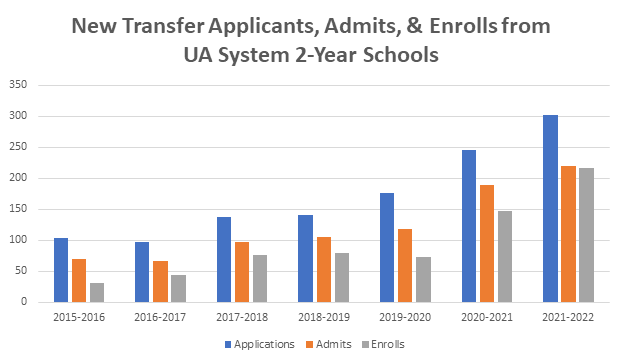You have /5 articles left.
Sign up for a free account or log in.
Many transfer students cite affordability as a driving concern. Given some of the unknowns for transfer students—such as which institution they will move to and how many of their credits will apply to program completion—it’s sometimes difficult to estimate what a bachelor’s degree will cost. The University of Arkansas’ new transfer scholarship program seeks to address these challenges.
The Arkansas Transfer Achievement Scholarship (ATAS), rolled out in fall 2019, has shown incredible growth, particularly among students from low-income and underrepresented backgrounds, including first-generation students. The scholarship pays the difference between the U of A’s base tuition hourly rate and the current base hourly rate at the two-year institution. So the student pays the same tuition at the U of A that they did at the two-year college. In the 2021–22 academic year, the award ranged between $121.51 and $186.51 per credit hour.
What Does ATAS Look Like?
To be eligible, students must be Arkansas residents who have completed an associate of arts, associate of science or associate of arts in teaching at one of the seven participating colleges and enroll at the U of A in an on-campus, undergraduate degree program the semester immediately following degree conferment. The award can be renewed for as many as 10 semesters, as long as students are continuously enrolled (full- or part-time) and stay in good academic standing.
- University of Arkansas Community College at Batesville
- University of Arkansas—Cossatot Community College
- University of Arkansas at Morrilton
- University of Arkansas Rich Mountain Community College
- University of Arkansas—Pulaski Tech
- University of Arkansas at Hope-Texarkana
- Phillips County Community College of the University of Arkansas
An Emphasis on Outreach and Recruitment
To announce the program, we partnered with registrars at participating system schools to share directory information for students with 45 hours or more or who had applied for graduation. Many schools have created information sheets for their students, and that contact information comes straight to the U of A’s Transfer Central office in admissions for follow-up. In 2020–21, an admission’s graduate assistant was on-site at one location to discuss the program with prospective students, and we are scheduled for more such visits in the future.
Other promotion channels include special webinars, attending orientation/welcome events for new students at two-year system schools and fliers customized for each school, in addition to regular recruitment efforts like visits and college fairs.
We’ve also presented to representatives from community college partners, such as faculty and advisers, to further promote transfers in the state. As we had done before the pandemic, we are again visiting their campuses and hosting transfer connections events on our sister campuses. Additionally, we have shared information about this innovative program at the Arkansas Community Colleges annual conference, the National Institute for the Study of Transfer Students annual conference and the Southern Association of Collegiate Registrars and Admissions Officers.
Impact on Equity and Outcomes
These outreach efforts have been successful. Following ATAS’s launch in May 2019, the number of applications, admissions and enrollments from the seven participating schools in the U of A system has grown significantly. By spring 2022, more students from these schools enrolled than had applied prior to the announcement.

Though we only have a small sample size so far—3,617 total transfer enrollments, with 101 being ATAS recipients (fall 2019–spring 2021)—we can see some general takeaways:
- The program is growing rapidly: in fall 2019, 11 percent of transfer students from Arkansas with an associate degree were ATAS students. In fall 2020, that number was 40 percent.
- The program is widely adopted by first-generation students: 61 percent of ATAS students are first generation compared to 44.8 percent of all new transfers.
- Students of color are well represented: 33.6 percent of ATAS recipients are students of color, compared to 30.9 percent of all new transfers.
- The program is being adopted among low-income students: 36.6 percent of ATAS students are Pell eligible compared to 17.1 percent of all new transfers.
- First-year retention rates are slightly higher among ATAS students—a two- to four-point increase
In looking at year to year, from fall 2019 to fall 2020:
- Retention improved among ATAS students (and those with an associate degree), even while it fell for all new transfers.
- The percentage of ATAS students who belong to an underrepresented group compared to those in-state students with an associate degree grew faster than the underrepresented rate among all new transfers.
- The same growth was seen for Pell-eligible and first-generation students.
- Entering GPA decreased among ATAS students and all new transfers, but it rose among those from Arkansas and those with an associate degree.
Beyond numbers, the ATAS has inspired six new academic agreements with system schools with more on the way.
This transfer scholarship program has shown incredible growth, provided exceptional opportunities for a wider pool of students, and increased student success among the transfer population. By addressing affordability and creating a bridge between two-year programs in our system to the University of Arkansas system’s flagship institution, ATAS is moving the state toward its goal of increasing college degree attainment among Arkansans.


